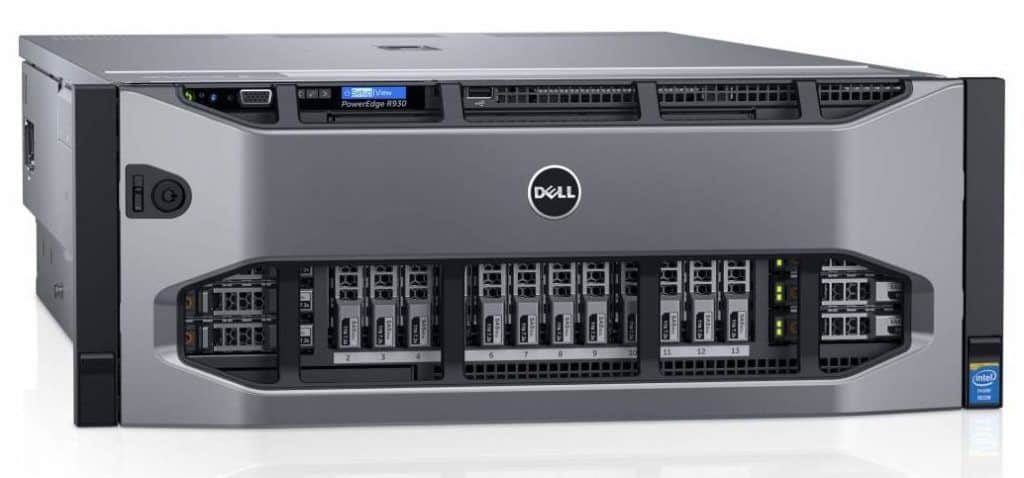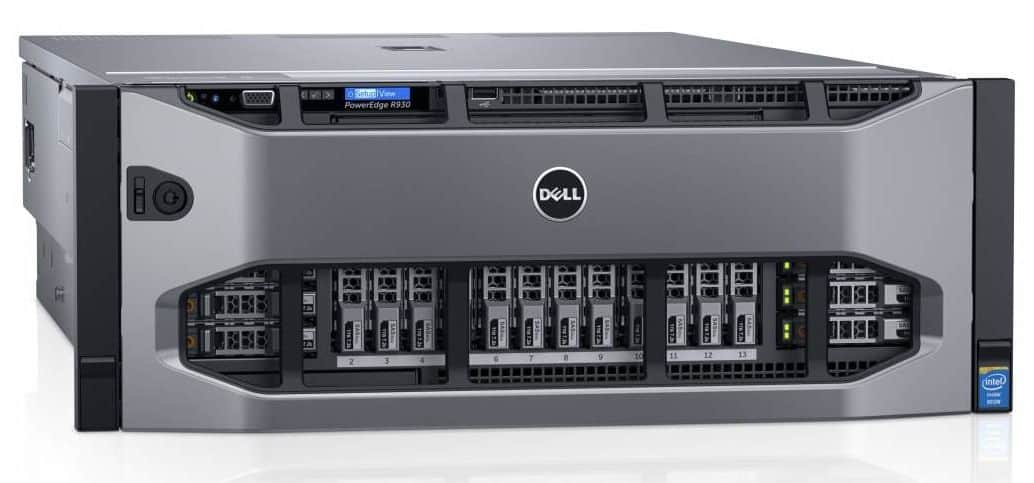amazon Dell PowerEdge R930 reviews
The Dell PowerEdge R930 server is part of the 13th generation Dell server family, providing a lot of potential from quad-core CPUs to eight-core. Form NVMe in 2.5 inch 4U format. The Dell PowerEdge R930 server is specifically designed to meet the needs of critical business applications with the combination of CPU, RAM and storage systems that this system delivers. Of course, the exact R930 is not a brand new effort, it was built on the 12th generation PowerEdge R920 by adding support for Intel Haswell processors with a new 3.2TB NVMe SSD more and larger capacity. The result is a 22% increase in performance over the previous generation, bringing the R930 into the system for applications ideally, where latency sensitivity is appreciated.
Like the previous generation, the Dell PowerEdge R930 Server is extremely versatile and designed for high-performance workloads. R930 pushes the Xeon E7 v3 processor up to 18 cores for every processor. That means on the R930 it is possible to use up to 72 processor cores and up to 6TB in its 96 DIMMs memory. You can easily use the drive combination of SAS and NVMe to get a better capacity and performance.
Besides the ability to accelerate performance, capacity and applications. The R930 is also designed to be easy to deploy, manage and use. The accompanying servers are also integrated with Dell’s latest remote control access (iDRAC8). iDRAC8 will automatically perform tasks including deployment, update, monitoring and maintenance. Dell claims that with this level of automation, it will save administration time and deploy servers significantly.
Highlights of the Dell PowerEdge R930
Form: 4U
Processor (up to four per unit):
Intel Xeon Processor E7-8800 Product Family
Intel Xeon Processor E7-4800 Product Family
Operating system:
Microsoft Windows Server 2008 R2
Microsoft Windows Server 2012
Microsoft Windows Server 2012 R2
Novell SUSE Linux Enterprise Server
Red Hat Enterprise Linux
VMware ESX
Chipset: Intel C602J
Memory: (96 DIMMs): 8GB / 16GB / 32GB DDR4 RDIMM, LRDIMM up to 1866MT / s
Storage:
2.5 “SATA / SAS SSD, SAS HDD (15K, 10K), nearline SAS HDD (7.2K)
2.5 “Dell PowerEdge NVMe Express Flash PCIe SSD
Drive bay:
Up to 24 x 2.5 “hot-plug 12Gb / 6Gb SAS HDD or SAS / SATA SSD
Up to 8 front-accessible Express Flash NVMe PCIe SSD (PCIe 3.0)
Number of slots:
Up to 10 PCIe 3.0 slots
1 RAID slot
1 NDC slot
RAID Controllers:
Internal controllers: PERC H330, PERC H730P
External HBAs (RAID): PERC H830
External HBAs (non-RAID): 12Gbps SAS HBA
Communications
Embedded NICs:
Broadcom 5720 quad-port 1Gb NDC
Broadcom 57800 2x10GB DA / SFP + + 2x1Gb BT NDC
Broadcom 57800 2x10Gb BT + 2x1Gb BT NDC
Broadcom 57840S quad-port 10Gb SFP + Direct Attach Rack NDC
Intel I350 quad-port 1GbE NDC
Intel X520 dual-port 10GB DA / SFP +, + I350 DP 1GbE, NDC
Intel X540 10GbE BT dual-port + I350 1Gb BT DP NDC
Power source: Hot-plug redundant PSUs: 750W AC, 1100W AC
Can be used more
Hot-plug hard drives
Hot-plug redundant power
Hot-plug redundant fans
ECC memory
Internal dual SD module
Graphics card: Matrox G200 with 8MB memory
Management capabilities
iDRAC8 with Lifecycle Controller
iDRAC8 Express (default)
iDRAC8 Enterprise (upgrade option)
8GB or 16GB vFlash media (upgrade options)
IPMI 2.0 compliant
Dell OpenManage Essentials
Dell OpenManage Mobile
Dell OpenManage Power Center
Dell OpenManage Integrations:
Dell OpenManage Integration Suite for Microsoft System Center
Dell OpenManage Integration for VMware vCenter
Dell OpenManage Connections:
HP Operations Manager, IBM Tivoli Netcool, and CA Network and Systems Management
Dell OpenManage Plug-in for Oracle Database Manager
Size
6.8 “(172.6mm)
W: 18.99 ”(482.4mm)
D: 31.59 ”(802.3mm) with PSU and bezel
D: 31.01 “(787.7mm) with PSU and without bezel
Design
According to the overall design, the Dell R930 looks almost identical to the R920 outside. In general, there are 24 drive bays, including 8 NVMe interfaces and the rest are SAS or SATA disks. The number of disk bays provides a lot of storage support for users, and the Input / Output potential will depend on the location where you place the server. On the front interface of the device there are many other ports such as a VGA port, two USB 2.0 ports, an SD card slot, and a space for an optional optical drive. Each drive will be equipped with status indicator LED and has an LCD screen that indicates the status of the system (with navigation button on the right side of the screen).
Like the R920, the Dell R930 also has a handle on the top to support it when it is placed on a stand.
Moving to the back of the device, we see 10 PCIe slots to expand the connection, add 2 USB 2.0 ports, a VGA port, a serial port, 4 Ethernet ports, and 4 PSUs.
Application performance analysis
Sysbench OLTP benchmark runs on Percona MySQL’s head, leveraging InnoDB storage tools operating inside a CentOS installation. The main difference is that instead of running a single benchmark on a bare metal server, we now run many of those standard cases in a virtualized environment to increase load. Finally, we implemented eight Sysbench virtual machines on the Dell PowerEdge R930, two virtual machines on the CPU, and simultaneously measured the overall performance seen on servers with all operations. This test is designed to show how powerful quad-CPU handles when the workload is constantly harsh. At the peak of the test, we were fully equipped with each system’s CPU resources as well as fully consumed 512GB of RAM provided in each server.
For the purpose of displaying the growth of Dell R930, we compared the R930 and R920 in the same repository. The configuration of the servers is quite tight, with clock speed compatibility, although the new generation Haswell CPU supports 3 extra DDR4 cores on each CPU. This allows the PowerEdge R930 server to increase processing power to 165.6GHz, while the old PowerEdge R920 “only” has 138GHz. Leveraging on the NVMe diskless version of each server, we chose the Intel P3700 2.0TB for proper storage between each server. This supply capacity is sufficient to run some standards, including MySQL TPC-C and SQL Server TPC-C.
where can you get a Dell PowerEdge R930 online
Dell PowerEdge R930 Server 2x E7-4809v4 2.1GHz 8-Core 64GB 2x 300GB 10K H730P (Certified Refurbished): Buy it now
4 x Intel Xeon Processor E7-8880 v3 (45M Cache, 2.30 GHz, 18-cores)
512GB RAM (16GB x 32 DDR4)
VMware ESXi vSphere 6.0
4 x 2TB Intel P3700 NVMe SSD
Dell PowerEdge R920 Server
4 x Intel Xeon Processor E7-8870 v2 (30M Cache, 2.30 GHz, 15-cores)
512GB RAM (8GB x 64 DDR3)
VMware ESXi vSphere 6.0
4 x 2TB Intel P3700 NVMe SSD
Each Sysbench VM is configured with three vDisk, one for boot (~ 92GB), one with pre-built (~ 447GB) database and third for databases that we will test (400GB ). From resources on the system, we have configured each virtual machine with 16 vCPUs, 64GB of DRAM memory and inherited LSI Logic SAS SCSI controller. For both R930 and R920 servers, we put two Sysbench virtual machines on each Intel NVMe SSD.
In average latency we see similar results, with the Dell PowerEdge R930 Server performing 25% better than the R920 with a 16ms delay compared to 24 ms.
In terms of the worst case of MySQL our latency (99 percentile), the R930 is a better Server with a latency of 32ms to a latency of 44ms of R920. This suggests that the CPU plays an important role in the central latency measurements, even with the same internal memory.
Conclude
The Dell PowerEdge R930 is a 4U server with a lot of flexibility, it can provide a lot of power to accelerate the workload to high performance. Dell R930 has 24 drive bays, of which 8 support NVMe (now supports larger 3.2TB drives). Among these, the drive bay users can mix and match SAS or SATA and SAS with NVMe. The server supports Haswell processors, supporting up to 18 cores for each processor; With four processors, the R930 can support 72 processor cores. The server has 96 DIMM slots that allow users to reduce costs and increase efficiency thanks to the capacity of up to 6TB of memory. Thanks to iDRAC8, the R930 will automate a number of managers’ management and usage processes that save time significantly.

